Baltimore Police Buttons Chronology - Before 1857 the police force in Baltimore, like most other American cities did not wear a standardized uniform or buttons. As a result, the officers' buttons for the Baltimore police during this time were probably civilian examples.

Baltimore Police Buttons Chronology
By Harry Eichman
Baltimore City Police Buttons
Until 1857, the police force in Baltimore, as in the majority of American communities, did not wear buttons or a consistent uniform. So, the buttons worn by Baltimore police officers during this time were likely civilian examples.
Generally, uniform buttons can be dated by inspecting the designs and marks on them and, if accessible, by consulting contemporary sources. Due to the use of outdated materials in new products, dating might be problematic at times. Moreover, the manufacturing date of a button does not necessarily indicate that it was utilized immediately. Some buttons were never issued and wound up in storage, while others were used for years after their design was altered by their owners. Lastly, sometimes the marks on the back of buttons do not reveal the button's manufacturer, but rather the name of the merchant who supplied the uniforms and subcontracted with a button manufacturer.
Some examples of the first Baltimore Police buttons with the letter P in the wreath (c. 1857-1860)
The first documented Baltimore City Police uniform buttons date back to the 1857 establishment of a professional police department in Baltimore. It has a Gothic letter P surrounded by a laurel wreath. These most likely come in two sizes: a 23 mm large coat size and a 15 mm cuff or hat size; however, no specimens of the hat size have yet been observed. Many blemishes may be found on the backs of these buttons of the first generation (called back-marks by collectors are noted).
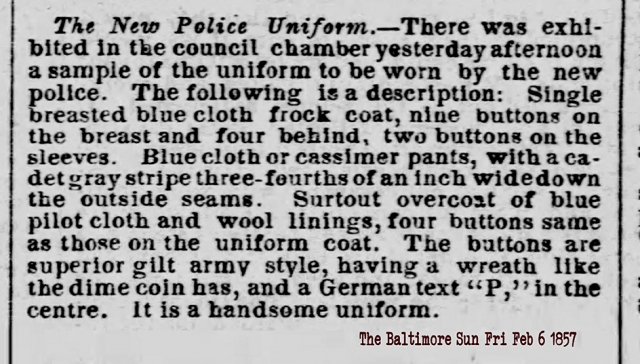
The February 6, 1857 issue of the Baltimore Sun described the new uniform buttons as "superior gilded army style with a wreath similar to the dime coin and a German letter 'P' in the center." HERE
According to the 2006 version of Military Button Manufacturers and Dealers: Their Backmarks and Dates by Bruce Bazelon and William McGuinn. In 1858, Baltimore die sinker Jacob Seeger cut the front design or "die" of this "P" wreath button and submitted it to the firm of Holmes, Booth & Hayden in Waterbury, Connecticut, who were agents for the Waterbury Button Co. He requested that the back of the buttons either bear his name or be blank. It's likely that the Waterbury Button Co. made the buttons with the backmark Jacob Seeger Baltimore for him sometime after 1865 but before 1865, when Seeger started working with metal and entered the brewery industry.

On the buttons bearing the Jacob Gminder Baltimore Maker-mark is a first-generation design that is somewhat altered. As reported by Bazelon and McGuinn, Jacob Gminder is first recorded as a trader in military and other uniform items in Baltimore in 1859. The vast majority of buttons bearing Gminder markings belong to the 1870s or later, when his business expanded. This specimen features a backmark design known as raised metal depressed channel. These RMDC backs were rarely used after the early 1860s, so it is probable that this Baltimore police button is likewise pre-1860.
These buttons were purchased from Scovill Mfg Co. in Waterbury, Connecticut, and not manufactured by Gminder. This is demonstrated by a silver-plated button with the same design as the gminder buttons but a scovill mg co Company back-mark. By 1861, Scovill had altered its back-mark to scovill mfg co., Waterbury. Unknown is the use of the silver-plated example, as all other first-generation BCPD examples currently discovered are gold gilded.

On the backs of first-generation BCPD buttons that are not depicted but have been reported, there is a series of five-pointed RMDC stars or the phrase "Extra Wealthy." These buttons were likely sold to Baltimore garment companies that could not afford to have the button manufacturer place their name on the back of the button and did not wish to advertise the button manufacturer's name.
*Note on P Wreath buttons
After the BCPD abandoned the P Wreath buttons in favor of the BCP Wreath buttons, the major US button manufacturers kept the dies for the "P" Wreath buttons. Midway during the 1860s, the major American button manufacturers began producing P-Wreath buttons as generic buttons for police officers. These buttons could be utilized by smaller police departments that cannot afford to have their own municipal seal imprinted on buttons, or as replacement buttons for lost buttons. (In the 19th century, police officers were required to take care of their uniforms so that a new one would not have to be purchased early and a coat deducted from their pay.)
By the aforementioned reasons, 99.5% of the P Wreath police buttons cannot be linked to the BCPD, although they were presumably used after 1860. The examples of buttons displayed are those that can be identified as belonging to the 1857–1860 force, while other examples are likely waiting to be uncovered.
2nd generation Baltimore City police buttons: 3 piece buttons with the BCP Wreath (1860-1870?)
In February of 1860, the Baltimore police force was once again restructured. The mayor and city council in Baltimore appointed the initial members of the professional police force. From 1857 and 1860, the mayor and city council were made up of members of the Know-Nothing or American Party, and they gave police positions to its supporters as patronage jobs. The inefficiency of the BCPD and the conduct of its "personnel," particularly during elections, led the BCPD's reputation as an effective civil institution to suffer as a result of the hiring of police officers based on political patronage rather than merit.
The 1860 restructuring of Baltimore's police department placed the agency under the command of a police board in an effort to lessen the local political party influence that had previously characterized the BCPD.
One of the effects of this reorganization was a change in the uniform and buttons of the Baltimore city police department. The new buttons were composed of three parts (front and back, held together by a rim). On the front of the buttons, the letters BCP for Baltimore City Police were displayed within a wreath. These three-piece buttons are known to as staff button style buttons because the three-piece button style was initially employed for United States Army staff officer buttons. They came in coat sizes of 23 mm and hat/cuff sizes of 15 mm.
It is believed that the Scovill Manufacturing Company produced all variants.
Although the Scovill MFG Co. of Waterbury, Connecticut, produced the Civil War-era version of these buttons, they bear the retailer's mark of Canfield Brothers & Co. of Baltimore. Canfield Bro & Co Baltimore is embroidered within two concentric rings of dots on the back of the coat size, while Canfield Bro & Co Bal is embroidered on the back of the cuff size. The outer crimped rim on the buttons is often modest on both the coat and cuff examples from the Civil War era, which is another feature used to conceal them.
(Pictures of both examples are required.)
During the Pratt street riot in 1861, the occupying federal forces stopped Baltimore's police until 1862, when they returned policing duties to civic authority.
The post-Civil War version of these buttons bears the back-mark of the Scovill Manufacturing Company of Waterbury, Connecticut. Coat-size and cuff size specimens contain a similar backmark of Scovill Mfg. Co Waterbury, surrounded by a ring of concentric dots. The outer crimped rim of the buttons on both the coat and cuff samples is significantly larger than on prior models.
(Pictures of both examples are needed.)
Third-generation police buttons in Baltimore:


Challenge Coins Available HERE

Disclaimer: This page's content is subject to change as new information becomes available, and the information shown is accurate to the best of our knowledge at this time. We are not experts or professional historians, but we are confident that the stated attributions and dates of BCP buttons are accurate based on our practical observations as button collectors and the knowledge gleaned from the sources we have investigated. We have not conducted extensive archival research or a full evaluation of primary sources on the topic; thus, we cannot guarantee that the material supplied is 100% accurate or exhaustive. That provides, at most, a general overview of the chronology and history of BCP buttons.

Brass Buttons Seized by War Efforts
1 Oct 1942
Brass Buttons Taboo, Policemen's Future Dark
The Evening Sunday, 1 October, 1942 page 27 and page 44
Officers confront the world grimly as the WPB [War Production Board] orders the polished brass fastereners of their gleaming new uniform coats removed.
Today, the Baltimore Police Department was in a hole - a BUTTONHOLE... The fortunes of war "shot" the traditional brass buttons from the Bluecoats' uniforms. Thankfully, the police have black plastic/ceeluloid pant buttons.
A button manufacturer in Waterbury, Connecticut, warned uniform manufacturers here that brass buttons for police uniforms will no longer be available, and the uniform manufacturers notified Commissioner Robert F. Stanton, who notified Senator George R. Radcliffe.
Could Wear Overalls
Senator Radcliffe extended his deepest heartfelt feelings—excuse me, sympathies—but stated he could do nothing to help the police department out of its predicament. He stated that the ban on the production of brass buttons was a War Production Board regulation that went into force on September 4, 1942.
The order restricts the use of brass buttons for all garments other than overalls and dungarees, which, if you ask the bluecoat on the beat, sounds a bit like rubbing it in.
What! No Pants?
The next graduating batch of probationary police officers will be the first members of the force to feel the pinch of the button crisis. Yet yesterday's 30th and final graduating class had a clue of the difficult times to come. They were required to graduate sans pants.
The commencement ceremony was held in the Police Building on the Fallsway. The graduates wore jackets, caps, white shirts, and black ties, but no trousers - uniform trousers. In addition, they cannot perform street duty until they have the new uniform pants.
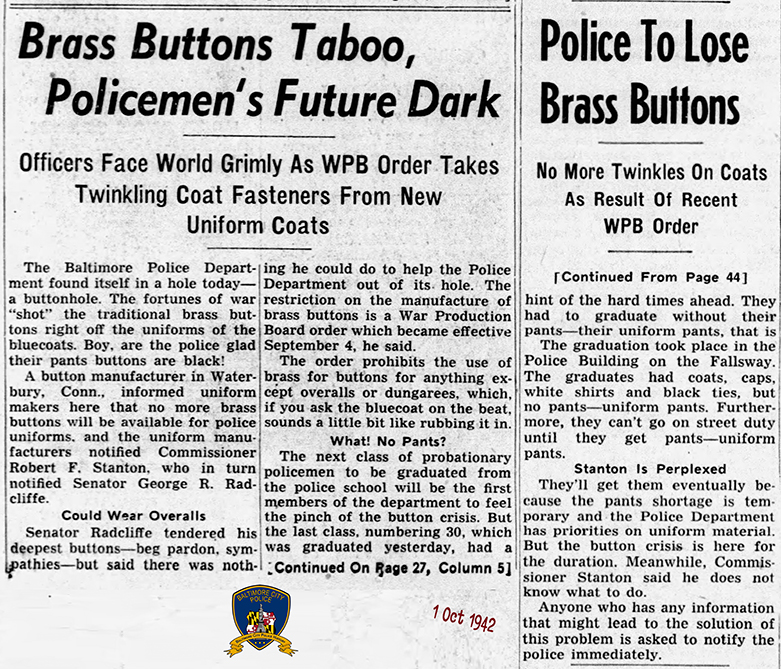
Click HERE or the above article to see full size article

Selected Sources
Bazelon, Bruce S. & McGuinn, William F., Military Button Makers and Dealers: Their Back-marks and Dates, 2006 Expanded Edition, 1984.
definitive proof, Baltimore P
For more information on the subject, CLICK HERE
Malka, Adam The Men of Mobtown: Policing Baltimore in the Age of Slavery and Emancipation, Chapel Hill: The University of North Carolina Press, 2018.
For more information, CLICK HERE
Folsom, De Francias ed., Our Police: A History of the Baltimore Force from the First Watchman to the Latest Appointee, Baltimore: J.M. Beers, 1888.
“The New Police Uniform,” Baltimore Sun, Baltimore, Maryland, Feb. 6, 1857.
Driscoll, Ret. Det Kenny. “BPD History” Baltimore Police History.
CLICK HERE (accessed April 1st, 2019).

Research and Findings
We are working on finding the correct buttons used by the BPD, We know our agency used a "Wreath & P" button, then we used the "BCP" buttons that were circa 1881/82sh, then we went to the "State Seal" button, then the Baltimore City Police with a State Seal. The first was a two-piece convex version much like the BCP button, but with just a MD State seal. Following the BCP button, we'll see a Baltimore City Police State Seal button, but unlike today's Baltimore City Police State Seal button, the earlier version was convex. A similar design on a flat button follows that earlier Baltimore City Police State Seal button.
We have the two-piece state seal button here someplace but without "Baltimore City Police" on it too... I'll find it, add it to these and re-take these shots.
We'll also add a plain black plastic button, to help tell a story of a time during the second world war, in which the war department wanted all brass for use in bullets, so any new uniforms issued had plastic buttons instead of brass buttons.
I am not 100% on the years or order of these, I am going by info, pictures, and a tiny little bit o common sense, Patty warns me not to waste too much of the tiny bit of common sense I have left




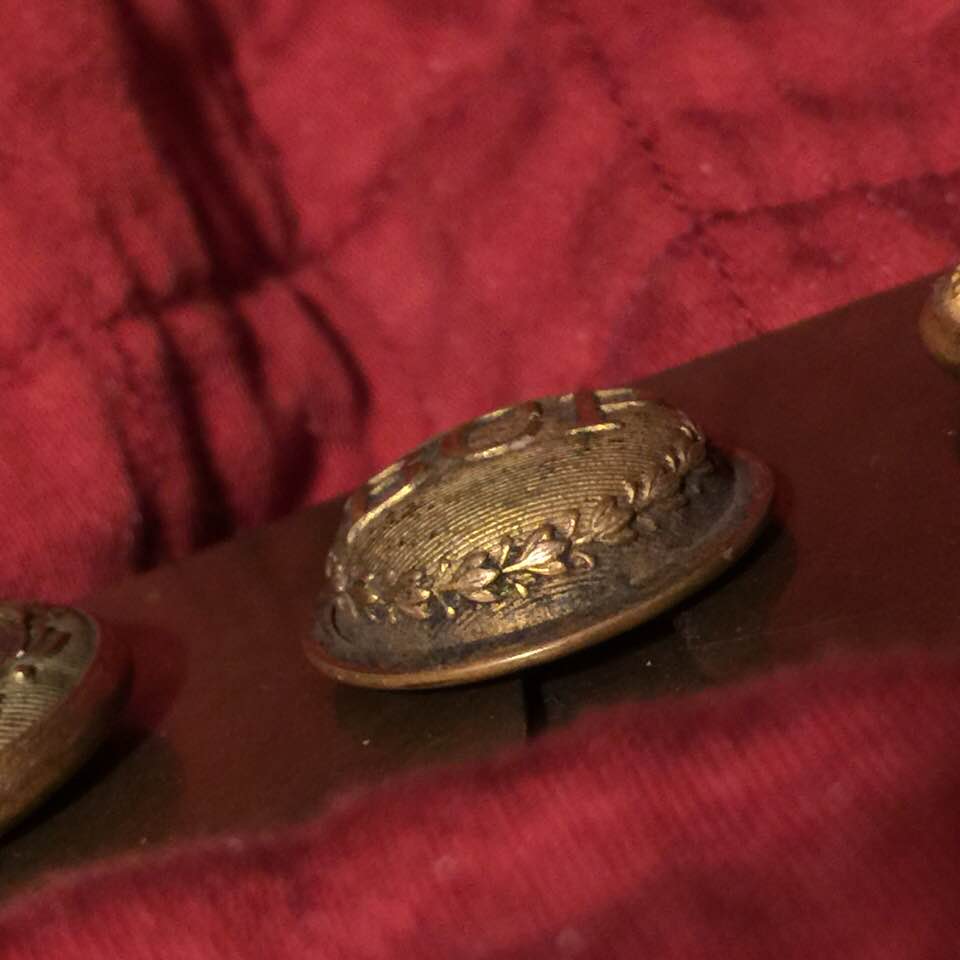

First Mention of a Baltimore City Police Button came in an article dated 1889
The Baltimore Sun Mon Apr 16 1889 HERE
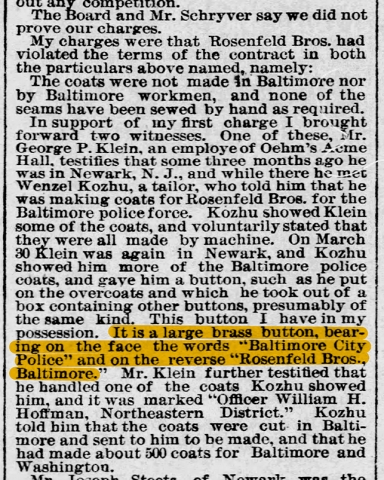
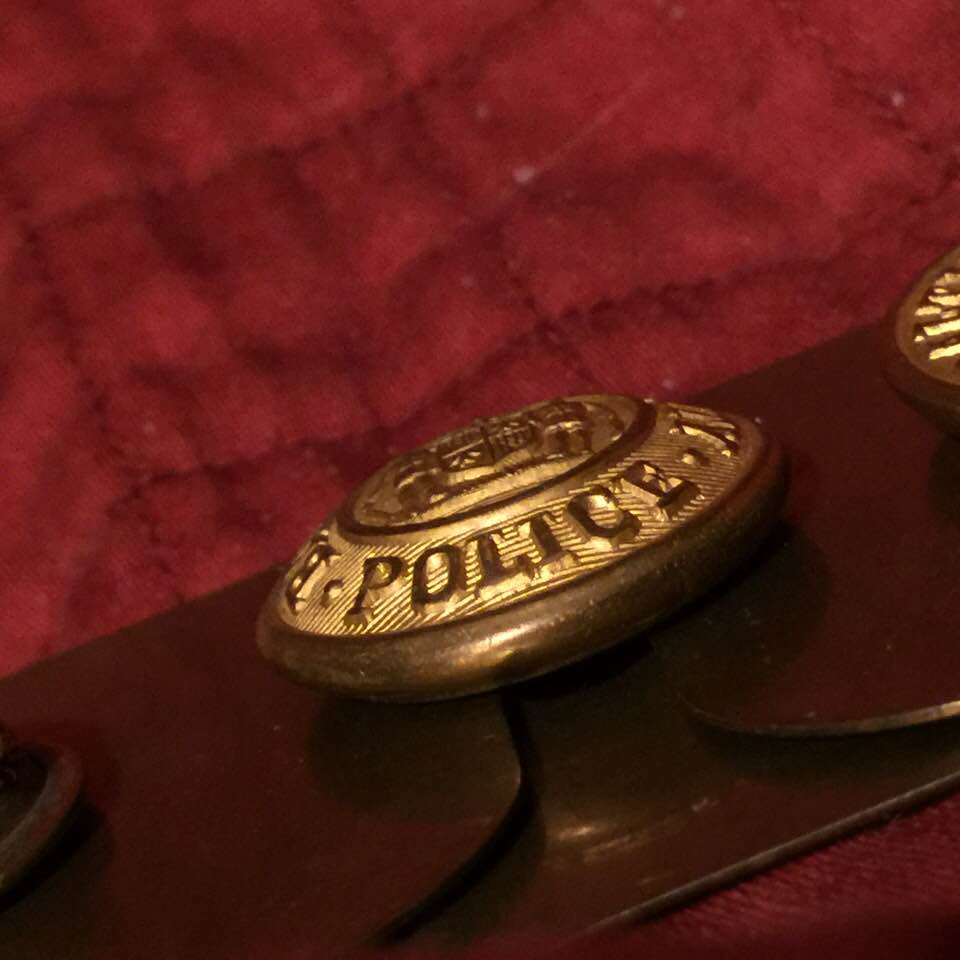
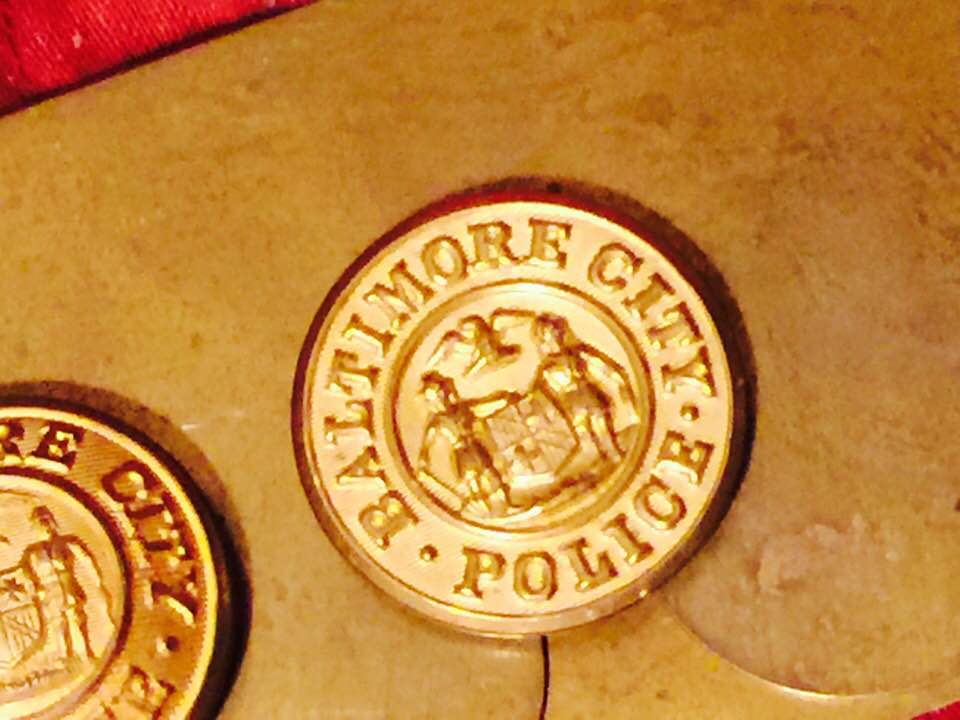
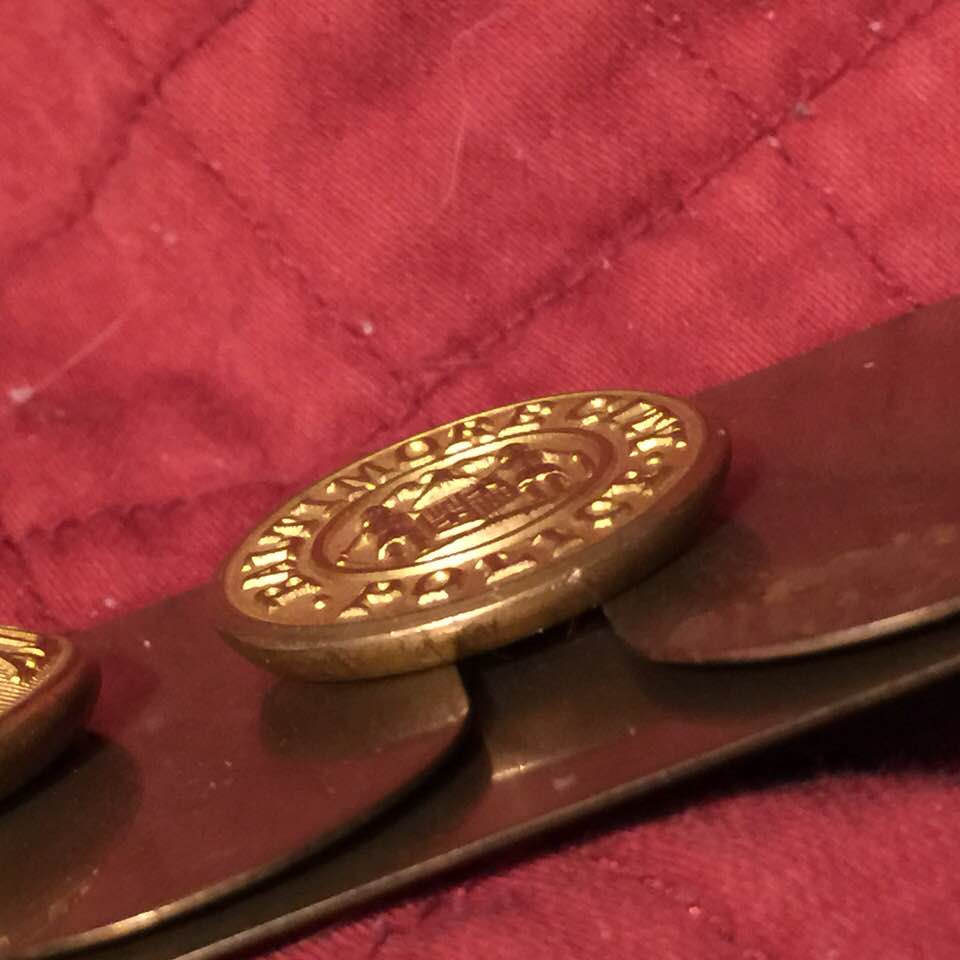

Baltimore Police State Seal Button
A little mix up on the State Seal Button, I was recently provided with a BPD State Seal Button that, on closer examination, had a Helm above the State Seal, whereas our old State Seal Button had an "Eagle." The correct button should have the HELM so we removed the one with the Eagle and replace it with the HELM
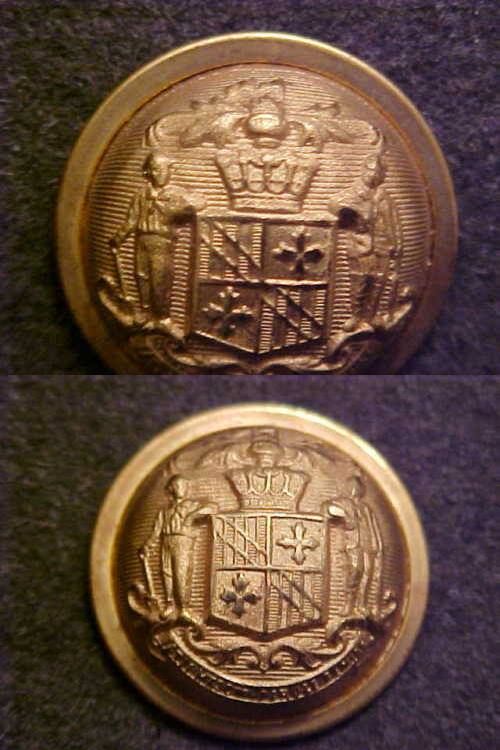
You might have noticed the Maryland Flag doesn't show up on the BPD Buttons until this button, it was once said it was because this was around the time the state took over management of the Baltimore Police. That could be part of it, however, the Maryland flag as we know it wasn't developed until after the civil War; actually, sometime around 1880 would be the first time it was recognized as our state flag, and it wasn't our official flag until much later. So, we didn't see it earlier because, prior to the civil war, it did not exist. Read more about it HERE

So in order, we would have them as they appear in the brass polishing tool below, minus some generic, plastic, wood and other buttons early on in the department before the "P Wreath Button," which came before the BCP Button, The BCP button wasn't around long, it was replaced around the time of the Civil War when Jacob Frey said something to the effect of, "The force being a state institution,'" he thought it appropriate "to have placed the Maryland coat of arms upon the badge," Shortly after it went on the badge, it was on our buttons, where it would remain until we started wearing the "Baltimore City Police Buttons," similar to those we see today. Unlike the later version of our Brass Police buttons, that are nearly flat, the first "Baltimore City Police Buttons" were convex, almost like a sliver of a child's toy ball. But our buttons today still have the influence of Marshal Frey in that we still have a State Seal on our badges and Buttons to this day, but rather than a HELM, we now have an EAGLE.
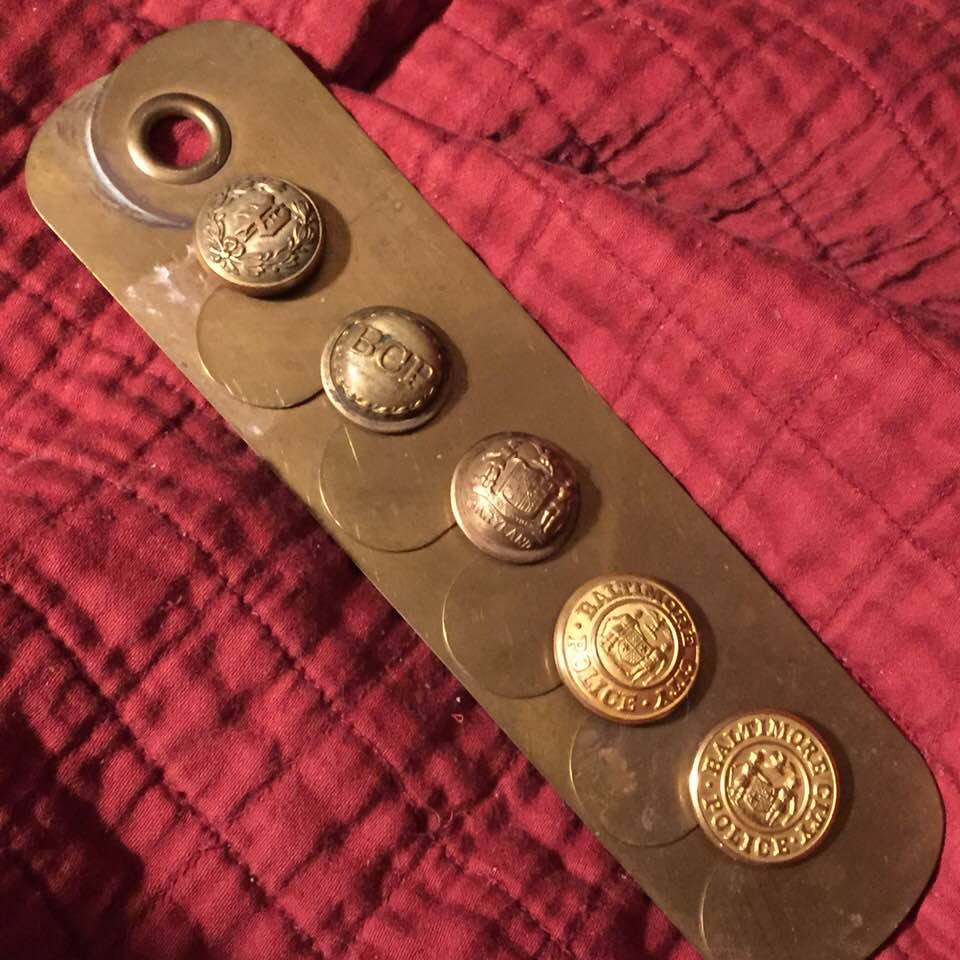

TIMELINE
The Following Timeline is based on what we have so far; we know changes will be made as further investigation continues and better information is gathered. For now, the early numbers are good; we will gather better numbers as we dig deeper into things.
1784 - 1857 - No Uniform Button
1857 - 1861 - "P" Wreath Button
1861 - 1863 - BCP Wreath Button
1863 - 1889 - State Seal with Helm Button
1889 - 1920 - Baltimore City Police "Convex" Button
1920 - Present - Baltimore City Police "Flat" Button
The first, "Flat Face" buttons we were able to date have a back-mark of "S. Eisner Red Bank, N.J." This company was only around for a short time in the early 1920s
Note: You might have noticed the Maryland flag didn't show up on the BPD buttons until this button. It was once said it was because this was around the time the state took over management of the Baltimore Police. That could be part of it; however, the Maryland flag as we know it wasn't developed until after the Civil War; actually, sometime around 1880 would be the first time it was recognized as our state flag, and it wasn't our official flag until much later. So, we didn't see it earlier because, prior to the civil war, it did not exist. Read more about it HERE

Brass Buttons Seized by War Efforts

1 Oct 1942
Brass Buttons, Taboo, Policemen's Future Dark
The Evening Sunday, 1 October, 1942. page 27 and page 44
Officers Face World Grimly as WPB [War Production Board] Order takes Twinkling Coat easterners From New uniform Coats.
The Baltimore Police Department found itself in a hole today—a BUTTONHOLE… The fortunes of war "shot" the tradition brass buttons right off the uniform of the Bluecoats. Boy, are the police glad their pants buttons are black!
A button manufacturer in Waterbury, Connecticut, informed uniform makers here that no more brass buttons will be available for police uniforms, and the uniform manufacturers notified Commissioner Robert F. Stanton, who in turn notified Senator George R. Radcliffe.
Could Wear Overalls
Senator Radcliffe tendered his deepest buttons—beg pardon, sympathies—but said there was nothing he could do to help the police department out of its hole. The restriction on the manufacture of brass buttons is a War Production Board order that became effective 4 September, 1942, he said.
The order prohibits the use of brass buttons for anything except overalls or dungarees, which, if you ask the bluecoat on the beat, sounds a little bit like rubbing it in.
What! No Pants?
The next class of probationary policemen to graduate from the police school will be the first members of the department to feel the pinch-of-the button crisis. But the last class, numbering 30, which was graduated yesterday, had a hint of the hard times ahead. They had to graduate without their pants, that is.
The graduation took place in the Police Building on the Fallsway. The graduates had coats, caps, white shirts and black ties, but no pants - uniform pants. Furthermore, they can't go on the street duty until they get uniform pants.
Stanton is Perplexed

Baltimore Police History Challenge Coin
Years ago, we had a challenge coin made to represent our departmental history. For this History coin, we chose a Baltimore City Police Button, and we went with the old Conex button as seen below
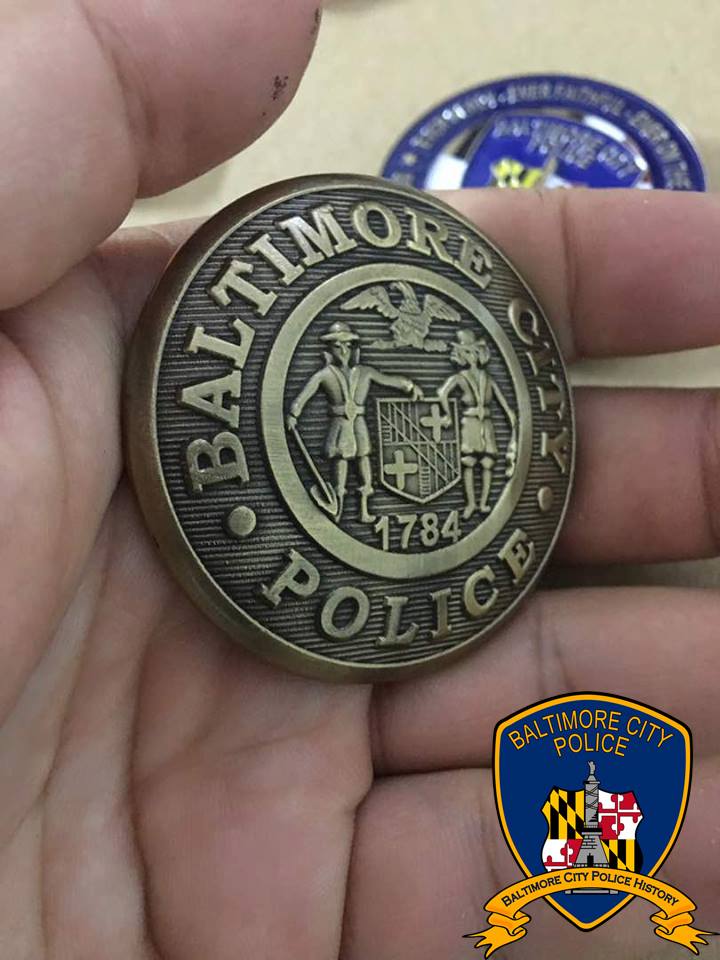
2018 BPD History Challenge Coin

POLICE INFORMATION
Copies of: Your Baltimore Police Department Class Photo, Pictures of our Officers, Vehicles, Equipment, Newspaper Articles relating to our department and or officers, Old Departmental Newsletters, Lookouts, Wanted Posters, and or Brochures. Information on Deceased Officers and anything that may help Preserve the History and Proud Traditions of this agency. Please contact Retired Detective Kenny Driscoll.
This email address is being protected from spambots. You need JavaScript enabled to view it.

NOTICE
How to Dispose of Old Police Items
Please contact Det. Ret. Kenny Driscoll if you have any pictures of you or your family members and wish them remembered here on this tribute site to Honor the fine men and women who have served with Honor and Distinction at the Baltimore Police Department.
Anyone with information, photographs, memorabilia, or other "Baltimore City Police" items can contact Ret. Det. Kenny Driscoll at This email address is being protected from spambots. You need JavaScript enabled to view it. follow us on Twitter @BaltoPoliceHist or like us on Facebook or mail pictures to 8138 Dundalk Ave. Baltimore, Md. 21222
Copyright © 2002 Baltimore City Police History - Ret Det. Kenny Driscoll
You May Like









































